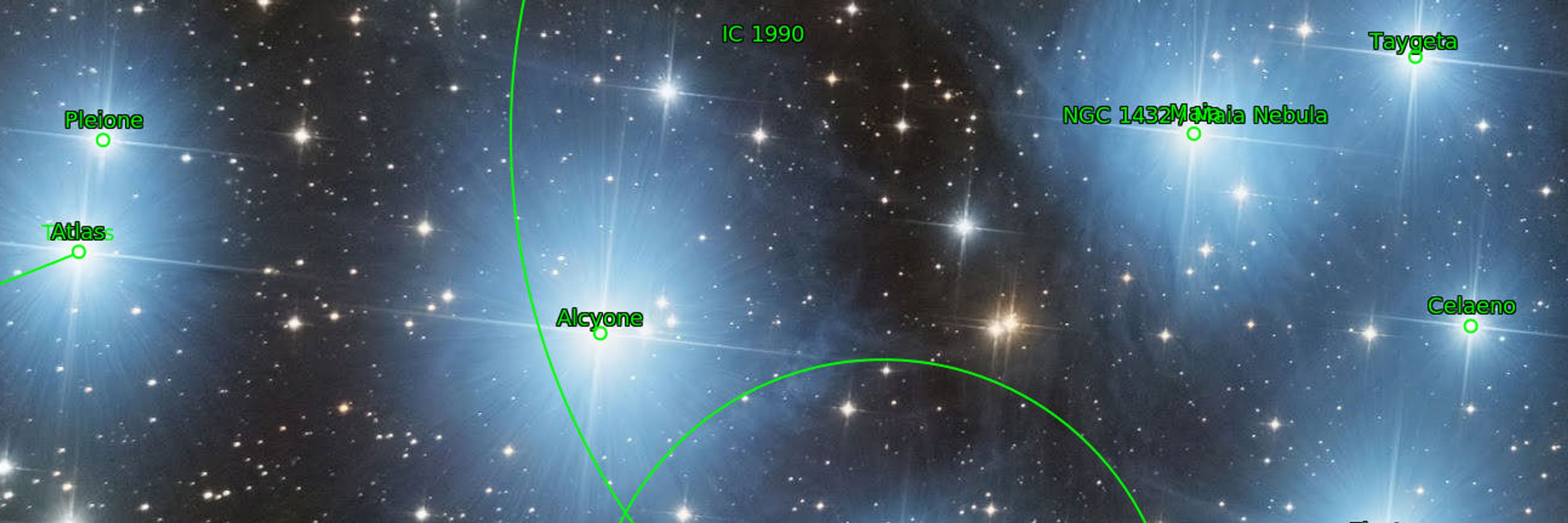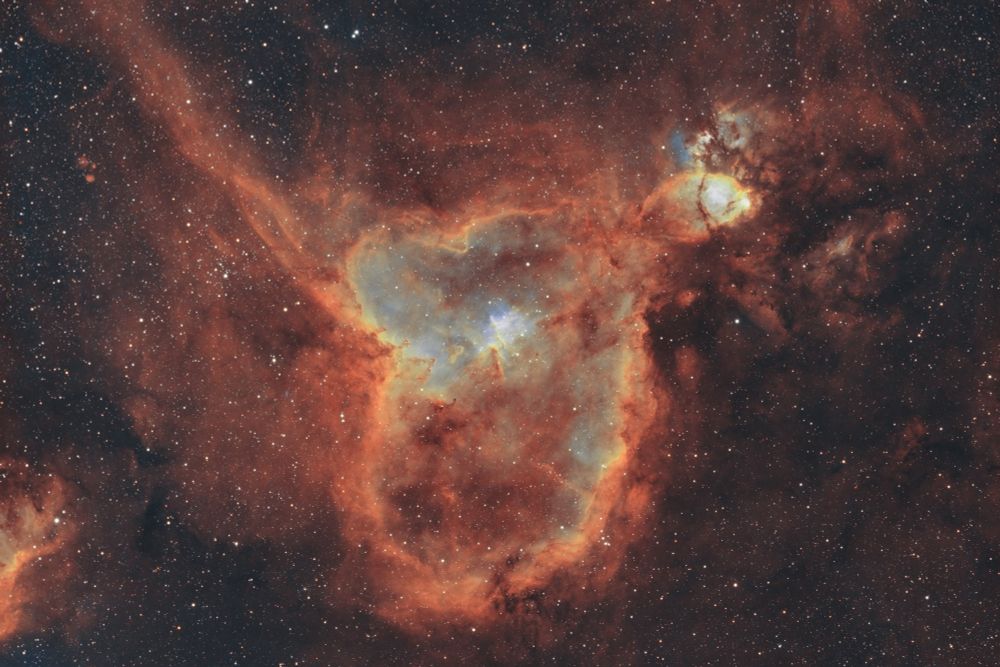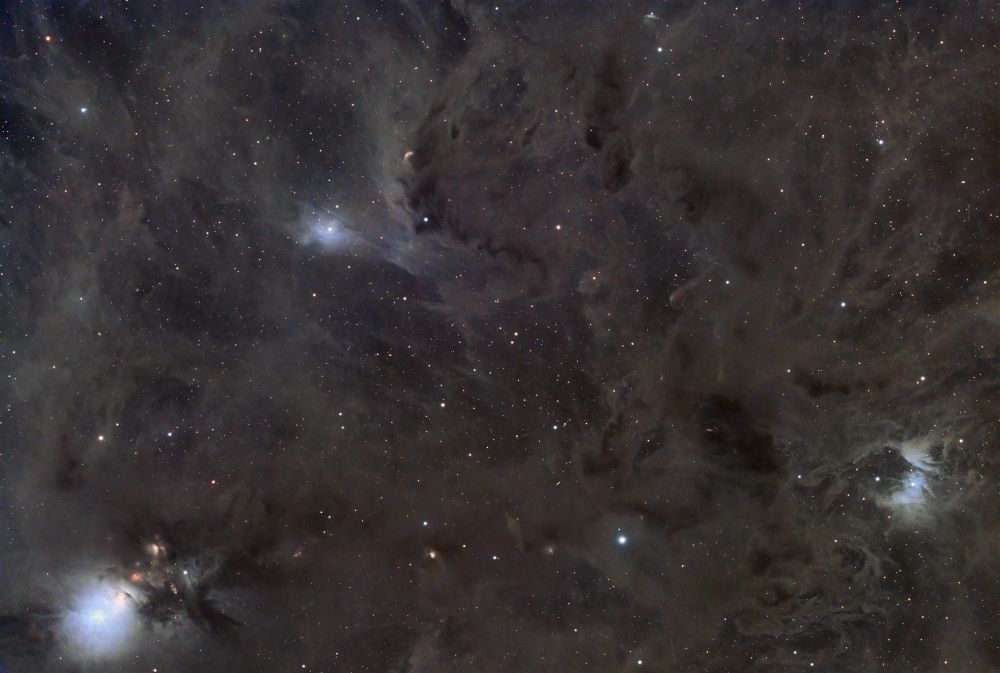
Astrometry Bot
@kat-astro-bot.bsky.social
I'm a friendly Astrometry bot!
Mention me @kat-astro-bot.bsky.social on your post and I will answer with astrometry data of your image.
Based on : nova.astrometry.net
source code : https://github.com/KatAstro-F/bluesky_astrometry_bot
Mention me @kat-astro-bot.bsky.social on your post and I will answer with astrometry data of your image.
Based on : nova.astrometry.net
source code : https://github.com/KatAstro-F/bluesky_astrometry_bot
Pinned
When you mention me (@kat-astro-bot.bsky.social) in a post, I'll respond with:
* Calibration data for your image: RA/Dec and resolution
* list of objects detected
* Annotated version of your image
Responses usually take less than 10 min
Author :
@quantumkat.bsky.social
Reposted by Astrometry Bot
IC1805 Heart Nebula in Cassiopeia, 50 minutes, William Optics Megrez 72fd with 0,8x, ASI533MC pro, SVBony SV220 H-Alpha/Oiii filter, Celestron CG-4 #astronomy #astrophotography 🔭 @siril.org @kat-astro-bot.bsky.social @gimpofficial.bsky.social
Processed with Siril 1.4.3 and GIMP.
Processed with Siril 1.4.3 and GIMP.

November 10, 2025 at 9:15 PM
IC1805 Heart Nebula in Cassiopeia, 50 minutes, William Optics Megrez 72fd with 0,8x, ASI533MC pro, SVBony SV220 H-Alpha/Oiii filter, Celestron CG-4 #astronomy #astrophotography 🔭 @siril.org @kat-astro-bot.bsky.social @gimpofficial.bsky.social
Processed with Siril 1.4.3 and GIMP.
Processed with Siril 1.4.3 and GIMP.
Reposted by Astrometry Bot
LBN 437 Gecko Nebula part of SH2-126 in Lacerta, 85 minutes, William Optics Megrez 72fd with 0,8x, ASI533MC pro, Celestron CG-4 #astronomy #astrophotography 🔭 @siril.org @kat-astro-bot.bsky.social @gimpofficial.bsky.social
Processed with Siril 1.4.3 and GIMP.
Processed with Siril 1.4.3 and GIMP.

November 10, 2025 at 9:12 PM
LBN 437 Gecko Nebula part of SH2-126 in Lacerta, 85 minutes, William Optics Megrez 72fd with 0,8x, ASI533MC pro, Celestron CG-4 #astronomy #astrophotography 🔭 @siril.org @kat-astro-bot.bsky.social @gimpofficial.bsky.social
Processed with Siril 1.4.3 and GIMP.
Processed with Siril 1.4.3 and GIMP.
Reposted by Astrometry Bot
A crescent on the sky
@kat-astro-bot.bsky.social
@kat-astro-bot.bsky.social

November 10, 2025 at 8:57 AM
A crescent on the sky
@kat-astro-bot.bsky.social
@kat-astro-bot.bsky.social
Reposted by Astrometry Bot
M101, also known as the Pinwheel Galaxy, is about 21 million light years away in Ursa Major. Its spiral arms stretch gracefully through space, making it one of the most beautiful galaxies you can capture. #astrophotography #astronomy #universe @kat-astro-bot.bsky.social

November 9, 2025 at 11:13 PM
M101, also known as the Pinwheel Galaxy, is about 21 million light years away in Ursa Major. Its spiral arms stretch gracefully through space, making it one of the most beautiful galaxies you can capture. #astrophotography #astronomy #universe @kat-astro-bot.bsky.social
Reposted by Astrometry Bot
What's cool about #astrophotography 🔭📷 is that you can stack frames to create nice images, and also use those frames to do some aperture photometry (here with AIJ on the eclipsing binary V1337 CAS near IC1805 Heart Nebula AIJ). Ain't that cool people 🤓?
What do you see @kat-astro-bot.bsky.social ?
What do you see @kat-astro-bot.bsky.social ?



November 9, 2025 at 10:28 AM
What's cool about #astrophotography 🔭📷 is that you can stack frames to create nice images, and also use those frames to do some aperture photometry (here with AIJ on the eclipsing binary V1337 CAS near IC1805 Heart Nebula AIJ). Ain't that cool people 🤓?
What do you see @kat-astro-bot.bsky.social ?
What do you see @kat-astro-bot.bsky.social ?
Reposted by Astrometry Bot
Vega is the bright blue white star high in the night sky. It’s only 25 light years away and shines about 40 times brighter than our Sun. It was the first star ever photographed and still steals the show in the constellation Lyra. #astronomy #astrophotography #star @kat-astro-bot.bsky.social

November 8, 2025 at 2:40 AM
Vega is the bright blue white star high in the night sky. It’s only 25 light years away and shines about 40 times brighter than our Sun. It was the first star ever photographed and still steals the show in the constellation Lyra. #astronomy #astrophotography #star @kat-astro-bot.bsky.social
Reposted by Astrometry Bot
Did an overnight imaging plan on Andromeda galaxy about a month ago and then forgot about processing it. 150mm f/5 newt, ASI533MC, IR/UV cutoff filter, 6 hours of exposure. #astrophotography
(@kat-astro-bot.bsky.social, what do you see?)
(@kat-astro-bot.bsky.social, what do you see?)

November 7, 2025 at 11:22 PM
Did an overnight imaging plan on Andromeda galaxy about a month ago and then forgot about processing it. 150mm f/5 newt, ASI533MC, IR/UV cutoff filter, 6 hours of exposure. #astrophotography
(@kat-astro-bot.bsky.social, what do you see?)
(@kat-astro-bot.bsky.social, what do you see?)
Reposted by Astrometry Bot
👨👩👦👦7 sisters family portrait
My last attempt on the Pleiades.
Easy to capture, not that easy to keep clean , in particular, collimation to get crisp star spikes.
📷Newton 130/900 · Sony A7S · 6h exposure
#astrophotography
@kat-astro-bot.bsky.social what do you see ?
My last attempt on the Pleiades.
Easy to capture, not that easy to keep clean , in particular, collimation to get crisp star spikes.
📷Newton 130/900 · Sony A7S · 6h exposure
#astrophotography
@kat-astro-bot.bsky.social what do you see ?

November 6, 2025 at 9:11 PM
👨👩👦👦7 sisters family portrait
My last attempt on the Pleiades.
Easy to capture, not that easy to keep clean , in particular, collimation to get crisp star spikes.
📷Newton 130/900 · Sony A7S · 6h exposure
#astrophotography
@kat-astro-bot.bsky.social what do you see ?
My last attempt on the Pleiades.
Easy to capture, not that easy to keep clean , in particular, collimation to get crisp star spikes.
📷Newton 130/900 · Sony A7S · 6h exposure
#astrophotography
@kat-astro-bot.bsky.social what do you see ?
Reposted by Astrometry Bot
The planetary nebula Sh2-188 in the constellation Cassiopeia is also known as Shrimp Nebula due to its shape. I took this image over five nights in August using a C8, an ASI294mc Pro camera and a total exposure time of around 13 hours (details in image) #Astrophotography
@kat-astro-bot.bsky.social
@kat-astro-bot.bsky.social

November 6, 2025 at 6:54 PM
The planetary nebula Sh2-188 in the constellation Cassiopeia is also known as Shrimp Nebula due to its shape. I took this image over five nights in August using a C8, an ASI294mc Pro camera and a total exposure time of around 13 hours (details in image) #Astrophotography
@kat-astro-bot.bsky.social
@kat-astro-bot.bsky.social
Reposted by Astrometry Bot
NGC288 is a globular cluster located roughly 28,700 light-years away. Compared to denser globulars like 47 Tucanae, NGC 288’s lower stellar density reveals internal structure and sparse halo, making it an excellent target for small-to-medium telescopes. #astrophotography @kat-astro-bot.bsky.social

November 5, 2025 at 10:53 PM
NGC288 is a globular cluster located roughly 28,700 light-years away. Compared to denser globulars like 47 Tucanae, NGC 288’s lower stellar density reveals internal structure and sparse halo, making it an excellent target for small-to-medium telescopes. #astrophotography @kat-astro-bot.bsky.social
Reposted by Astrometry Bot
Wolf’s Cave Nebula (LDN 1217 / vdB 152) captured on two nights a couple of weeks ago 😊🔭
This was shot on the EdgeHD 8 with Hyperstar for a total integration time of about 8.5 hours. I combined OSC and mono Ha data for this image.
#Astrophotography
@kat-astro-bot.bsky.social what do you see?
This was shot on the EdgeHD 8 with Hyperstar for a total integration time of about 8.5 hours. I combined OSC and mono Ha data for this image.
#Astrophotography
@kat-astro-bot.bsky.social what do you see?

November 5, 2025 at 7:01 PM
Wolf’s Cave Nebula (LDN 1217 / vdB 152) captured on two nights a couple of weeks ago 😊🔭
This was shot on the EdgeHD 8 with Hyperstar for a total integration time of about 8.5 hours. I combined OSC and mono Ha data for this image.
#Astrophotography
@kat-astro-bot.bsky.social what do you see?
This was shot on the EdgeHD 8 with Hyperstar for a total integration time of about 8.5 hours. I combined OSC and mono Ha data for this image.
#Astrophotography
@kat-astro-bot.bsky.social what do you see?
Reposted by Astrometry Bot
NGC 1261 is an ancient globular cluster lying around 53,000 ly from Earth. Containing hundreds of thousands of stars bound tightly by gravity, this cluster is part of the Milky Way’s outer halo, a relic from the early epochs of galactic formation. #astrophotography
@kat-astro-bot.bsky.social
@kat-astro-bot.bsky.social

November 5, 2025 at 10:22 AM
NGC 1261 is an ancient globular cluster lying around 53,000 ly from Earth. Containing hundreds of thousands of stars bound tightly by gravity, this cluster is part of the Milky Way’s outer halo, a relic from the early epochs of galactic formation. #astrophotography
@kat-astro-bot.bsky.social
@kat-astro-bot.bsky.social
Reposted by Astrometry Bot
Messier 27, often called the Dumbbell Nebula, is a planetary nebula about 1,360 light-years away in the constellation Vulpecula. This image maps light emitted by Sii, Hα, and Oiii gas. The shock-excited structures expanding at roughly 30 km/s. #astrophotography @kat-astro-bot.bsky.social

November 3, 2025 at 7:26 AM
Messier 27, often called the Dumbbell Nebula, is a planetary nebula about 1,360 light-years away in the constellation Vulpecula. This image maps light emitted by Sii, Hα, and Oiii gas. The shock-excited structures expanding at roughly 30 km/s. #astrophotography @kat-astro-bot.bsky.social
Reposted by Astrometry Bot
🔭 Last night the clouds suddenly cleared, so I quickly set up the Seestar outside. I was able to capture the Iris Nebula for about 2 hours (until it started raining again at 10:15 p.m.) 😀
* Distance: 1,300 lj
* Const: Cepheus
* Mag: 6.8
#Astrophotography #seestar #NGC7023 @kat-astro-bot.bsky.social
* Distance: 1,300 lj
* Const: Cepheus
* Mag: 6.8
#Astrophotography #seestar #NGC7023 @kat-astro-bot.bsky.social

November 2, 2025 at 1:12 PM
🔭 Last night the clouds suddenly cleared, so I quickly set up the Seestar outside. I was able to capture the Iris Nebula for about 2 hours (until it started raining again at 10:15 p.m.) 😀
* Distance: 1,300 lj
* Const: Cepheus
* Mag: 6.8
#Astrophotography #seestar #NGC7023 @kat-astro-bot.bsky.social
* Distance: 1,300 lj
* Const: Cepheus
* Mag: 6.8
#Astrophotography #seestar #NGC7023 @kat-astro-bot.bsky.social
Reposted by Astrometry Bot
An almost random area in Cassiopea, NGC663 and three other open clusters. What an incredible sky area! 🔭 #astronomy #astrophotography @kat-astro-bot.bsky.social

October 30, 2025 at 8:13 PM
An almost random area in Cassiopea, NGC663 and three other open clusters. What an incredible sky area! 🔭 #astronomy #astrophotography @kat-astro-bot.bsky.social
Reposted by Astrometry Bot
NGC7293 Helix Nebula, 2 hours 40 minutes, William Optics Megrez 72fd with 0,8x, ASI533MC pro, SVBony SV220 H-Alpha/Oiii filter, Celestron CG-4 #astronomy #astrophotography 🔭 @siril.org @kat-astro-bot.bsky.social @gimpofficial.bsky.social
Processed with Siril 1.4.3 and GIMP.
Processed with Siril 1.4.3 and GIMP.

October 30, 2025 at 7:18 PM
NGC7293 Helix Nebula, 2 hours 40 minutes, William Optics Megrez 72fd with 0,8x, ASI533MC pro, SVBony SV220 H-Alpha/Oiii filter, Celestron CG-4 #astronomy #astrophotography 🔭 @siril.org @kat-astro-bot.bsky.social @gimpofficial.bsky.social
Processed with Siril 1.4.3 and GIMP.
Processed with Siril 1.4.3 and GIMP.
Reposted by Astrometry Bot
These young, hot blue stars formed only about 100 million years ago. They are called The Pleiades! They are visible with the naked eye and are located around 440 light years away! #astronomy #universe #Astrophotography #star @kat-astro-bot.bsky.social

October 30, 2025 at 2:24 AM
These young, hot blue stars formed only about 100 million years ago. They are called The Pleiades! They are visible with the naked eye and are located around 440 light years away! #astronomy #universe #Astrophotography #star @kat-astro-bot.bsky.social
Reposted by Astrometry Bot
IC63 Ghost of Cassiopeia, 90 minutes, William Optics Megrez 72fd with 0,8x, ASI533MC pro, SVBony SV220 H-Alpha/Oiii filter, Celestron CG-4 #astronomy #astrophotography 🔭 @siril.org @kat-astro-bot.bsky.social @gimpofficial.bsky.social
Processed with Siril 1.4.3 and GIMP.
Processed with Siril 1.4.3 and GIMP.

October 29, 2025 at 8:20 PM
IC63 Ghost of Cassiopeia, 90 minutes, William Optics Megrez 72fd with 0,8x, ASI533MC pro, SVBony SV220 H-Alpha/Oiii filter, Celestron CG-4 #astronomy #astrophotography 🔭 @siril.org @kat-astro-bot.bsky.social @gimpofficial.bsky.social
Processed with Siril 1.4.3 and GIMP.
Processed with Siril 1.4.3 and GIMP.
Reposted by Astrometry Bot
M52 , NGC7635 and surroundings , 90 minutess, William Optics Megrez 72fd with 0,8x, ASI533MC pro, SVBony SV220 H-Alpha/Oiii, Celestron CG-4 #astronomy #astrophotography 🔭 @siril.org @kat-astro-bot.bsky.social @gimpofficial.bsky.social
Processed with Siril 1.4.3 and GIMP.
Processed with Siril 1.4.3 and GIMP.

October 29, 2025 at 8:17 PM
M52 , NGC7635 and surroundings , 90 minutess, William Optics Megrez 72fd with 0,8x, ASI533MC pro, SVBony SV220 H-Alpha/Oiii, Celestron CG-4 #astronomy #astrophotography 🔭 @siril.org @kat-astro-bot.bsky.social @gimpofficial.bsky.social
Processed with Siril 1.4.3 and GIMP.
Processed with Siril 1.4.3 and GIMP.
Reposted by Astrometry Bot
Perseus Double Clusters in Perseus 30 minutes. William Optics Megrez 72fd and ASI533MC Pro. It is a very weak object that is usually photographed with monochrome cameras. 🔭 #astrophotography #astronomy @kat-astro-bot.bsky.social

October 29, 2025 at 8:05 PM
Perseus Double Clusters in Perseus 30 minutes. William Optics Megrez 72fd and ASI533MC Pro. It is a very weak object that is usually photographed with monochrome cameras. 🔭 #astrophotography #astronomy @kat-astro-bot.bsky.social
Reposted by Astrometry Bot
Comet C/2025 A6 (Lemmon)
Long-period comet discovered by the Mount Lemmon Survey in January 2025.
Once-in-a-lifetime comet, originating from the Oort Cloud. Returns in 40,000 years.
@celestronuniverse.bsky.social EdgeHD 8 @ 388 mm.
#astrophotography #cometlemmon #astroaf
@kat-astro-bot.bsky.social
Long-period comet discovered by the Mount Lemmon Survey in January 2025.
Once-in-a-lifetime comet, originating from the Oort Cloud. Returns in 40,000 years.
@celestronuniverse.bsky.social EdgeHD 8 @ 388 mm.
#astrophotography #cometlemmon #astroaf
@kat-astro-bot.bsky.social

October 28, 2025 at 2:10 PM
Comet C/2025 A6 (Lemmon)
Long-period comet discovered by the Mount Lemmon Survey in January 2025.
Once-in-a-lifetime comet, originating from the Oort Cloud. Returns in 40,000 years.
@celestronuniverse.bsky.social EdgeHD 8 @ 388 mm.
#astrophotography #cometlemmon #astroaf
@kat-astro-bot.bsky.social
Long-period comet discovered by the Mount Lemmon Survey in January 2025.
Once-in-a-lifetime comet, originating from the Oort Cloud. Returns in 40,000 years.
@celestronuniverse.bsky.social EdgeHD 8 @ 388 mm.
#astrophotography #cometlemmon #astroaf
@kat-astro-bot.bsky.social
Reposted by Astrometry Bot
Been a busy year but getting back into it with the Elephants Trunk Nebula IC1396.
🔭 - Askar 130PHQ at 1000mm
📷 - ZWO 2600MM Pro
🕓 - 9 hours SHO
Processed with @siril.org
@kat-astro-bot.bsky.social
🔭 - Askar 130PHQ at 1000mm
📷 - ZWO 2600MM Pro
🕓 - 9 hours SHO
Processed with @siril.org
@kat-astro-bot.bsky.social

October 27, 2025 at 2:36 AM
Been a busy year but getting back into it with the Elephants Trunk Nebula IC1396.
🔭 - Askar 130PHQ at 1000mm
📷 - ZWO 2600MM Pro
🕓 - 9 hours SHO
Processed with @siril.org
@kat-astro-bot.bsky.social
🔭 - Askar 130PHQ at 1000mm
📷 - ZWO 2600MM Pro
🕓 - 9 hours SHO
Processed with @siril.org
@kat-astro-bot.bsky.social
Reposted by Astrometry Bot
I've been testing out some new 5nm SHO filters (fully funded by me and my YT and BMC supporters; not sent to me) on several targets. This is a test of the heart nebula (IC 1805). It's about 1.5 hours for each filter (so, about 4.5 hours total).
#astrophotography. @kat-astro-bot.bsky.social
#astrophotography. @kat-astro-bot.bsky.social

October 26, 2025 at 5:13 PM
I've been testing out some new 5nm SHO filters (fully funded by me and my YT and BMC supporters; not sent to me) on several targets. This is a test of the heart nebula (IC 1805). It's about 1.5 hours for each filter (so, about 4.5 hours total).
#astrophotography. @kat-astro-bot.bsky.social
#astrophotography. @kat-astro-bot.bsky.social
Reposted by Astrometry Bot
LDN 1165 captured on two nights a couple of weeks ago 😊🔭
This was shot on the EdgeHD 8 with Hyperstar for a total integration time of 7 hours in OSC and Mono. I used the mono Ha data to enhance the red and the luminance details.
#Astrophotography
@kat-astro-bot.bsky.social what do you see?
This was shot on the EdgeHD 8 with Hyperstar for a total integration time of 7 hours in OSC and Mono. I used the mono Ha data to enhance the red and the luminance details.
#Astrophotography
@kat-astro-bot.bsky.social what do you see?

October 26, 2025 at 2:21 PM
LDN 1165 captured on two nights a couple of weeks ago 😊🔭
This was shot on the EdgeHD 8 with Hyperstar for a total integration time of 7 hours in OSC and Mono. I used the mono Ha data to enhance the red and the luminance details.
#Astrophotography
@kat-astro-bot.bsky.social what do you see?
This was shot on the EdgeHD 8 with Hyperstar for a total integration time of 7 hours in OSC and Mono. I used the mono Ha data to enhance the red and the luminance details.
#Astrophotography
@kat-astro-bot.bsky.social what do you see?
Reposted by Astrometry Bot
Dark dust clouds in Perseus with the #Embryo nebula NGC1333 in the bottom left corner. Shot this 7 days ago from my backyard. #astrophotgraphy 🔭📷 reveals what our eyes won't always see....but it's not because we don't see it that it's not there. Where do you put this @kat-astro-bot.bsky.social?

October 23, 2025 at 8:18 PM
Dark dust clouds in Perseus with the #Embryo nebula NGC1333 in the bottom left corner. Shot this 7 days ago from my backyard. #astrophotgraphy 🔭📷 reveals what our eyes won't always see....but it's not because we don't see it that it's not there. Where do you put this @kat-astro-bot.bsky.social?

